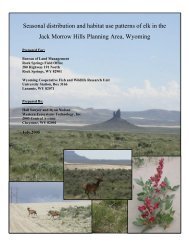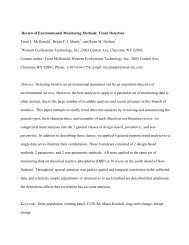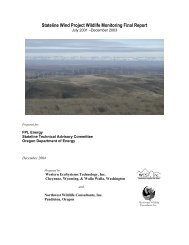Jackson Hole Pronghorn Study - WEST, Inc.
Jackson Hole Pronghorn Study - WEST, Inc.
Jackson Hole Pronghorn Study - WEST, Inc.
You also want an ePaper? Increase the reach of your titles
YUMPU automatically turns print PDFs into web optimized ePapers that Google loves.
Winter Range Distribution and Designation:<br />
An estimated 1,500-2,000 pronghorn, including ~85% (n=27) of the radiocollars,<br />
wintered along the southern end of the Mesa and the Sand Springs Draw area,<br />
adjacent to the New Fork River (Fig.2). Much of this winter range is designated as<br />
crucial winter range by the WGFD and is included in the Pinedale Anticline Oil and Gas<br />
Project Area (USDI-BLM 2000). Several pronghorn drifted between the New Fork<br />
winter range and the Yellow Point Ridge/Sand Draw country in the Jonah Field. Few<br />
pronghorn (15%, n=5) spent the majority of winter south of the New Fork winter range<br />
and WY Highway {351} (Fig.3). Three of these shifted between the Jonah Field and the<br />
Big Sandy River, while 2 remained in the Fourmile Gulch area near Seedskadee,<br />
approximately 150 miles (241 km) from their summer range. All radio-collared<br />
pronghorn remained east of the Green River and west of U.S. Highway {191}.<br />
Radio-collared pronghorn were usually distributed among 15-20 distinct herds<br />
that totaled about 2,000 animals. Winter (November-April) distribution of GTNP and<br />
GVRD pronghorn was similar and mixing of groups common. There were no reports of<br />
pronghorn attempting to over-winter in the JHV, GTNP, GVRD, or upper Green River<br />
during the course of the study.<br />
Winter Range Fidelity:<br />
Fidelity to winter range was examined for 28 radio-collared pronghorn. Most (86<br />
%, n=24) pronghorn demonstrated a high fidelity to winter ranges, occupying<br />
consecutive wintering areas ≤ 3-5 miles (5-8 km) apart. Periodic southerly movements<br />
of 10-20 miles were made by 8 of the 24, but only for brief time periods. It is generally<br />
believed that this pronghorn population moves further south as winter severity<br />
increases. The 4 (14%) pronghorn that did not use the same winter ranges during<br />
consecutive years appeared to be very mobile and never remained in one area for<br />
long. It was not uncommon for these pronghorn to move 20-40 miles (32-64 km) at any<br />
given time during the winter.<br />
Spring 1999 Migration (Figs. 4,5):<br />
“Early in the spring of 1890, a party consisting of two trappers and three prospectors, besides myself, were going up the western side of the<br />
Green River, in Wyoming, as rapidly as the melting snow would allow. The wild animals were going up the river valley at the same time. Large<br />
bands of Antelope travelled parallel with us, and being unmolested (as for a number of days not a shot was fired), they would dash by within a<br />
hundred yards of us.”<br />
---excerpt from Lives of Game Animals by Ernest Thompson Seton<br />
Because pronghorn movements were restricted by snowpack, migration data<br />
collected during the spring was more complete than the fall. <strong>Pronghorn</strong> were observed<br />
migrating during all daylight hours, but no information on night movements was<br />
collected. Mild weather conditions in March,1999 melted most snow on the Mesa and<br />
surrounding sagebrush habitats. <strong>Pronghorn</strong> began the northerly spring migration by<br />
shifting from the gentle southern breaks to the top of the Mesa. This shift in distribution<br />
occurred at the same time as radio-collared mule deer (Odocoileus hemionus) began<br />
leaving the Mesa (Sawyer and Lindzey 1999). An estimated 1,500 pronghorn occupied<br />
the top portion of the Mesa through early April, until they continued north from the Mesa<br />
10









